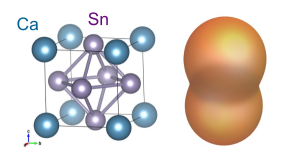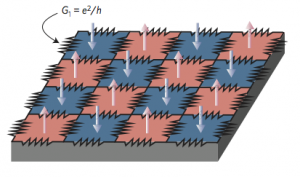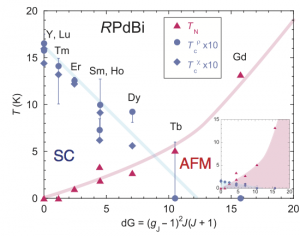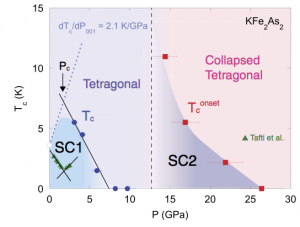Our research focuses on design, crystal growth, and characterization of novel quantum materials, particularly topological semimetals/insulators, unconventional superconductors, and quantum critical metals, by using the techniques described below.
Materials synthesis:
Metallic flux, vapor transport, hydrothermal synthesis
Bulk property measurements:
Charge/thermal/thermoelectric transport and thermodynamic measurements at very low temperatures in high magnetic field and/or under high pressure
RESEARCH HIGHLIGHTS
Nematic Superconductivity
Superconductors that break rotational symmetry are called nematic superconductors by analogy with a nematic phase, in which the rotational symmetry is broken while the translational symmetry is preserved. Nematic superconductors can have odd-parity superconducting pairing states,which is a key ingredient to topological superconductivity. In deed, in the topological superconductor candidate metal-intercalated Bi2Se3, the nematic superconducting state has been evidenced experimentally by the rotational symmetry breaking in heat capacity and nuclear magnetic resonance measurements.

Crystal structure of CaSn3 (left) and the nematic gap structure of CaSn3 compatible with our experimental results (right)
Recently, the binary stannide semimetal CaSn3, crystallizing in the cubic AuCu3-type structure with point group Oh, has been proposed as a prime candidate for a topological superconductor. We have revealed the rotational-symmetry breaking about a C4 axis in the upper critical field in this material. In addition, our μSR measurements unveil its fully-gapped superconducting state without time-reversal-symmetry breaking. Our observations suggest that an odd-parity nematic superconducting pairing state is realized in CaSn3 [Phys. Rev. B 105, 094508 (2022)].
Fermiology of a topological semimetal
The Fermiology of the normal state is crucial to discover topological superconductors. In particular, the number of time-reversal-invariant momenta (TRIM) in the Brillouin zone enclosed by Fermi surfaces is tightly linked to the topological class of time-reversal-invariant systems.
Recently the binary stannide semimetal CaSn3 has been proposed to be a promising candidate for realizing topological superconductivity, as it is predicted to be a topologically nontrivial semimetal. Our quantum oscillations measurements of this material, with the assistance of band calculations, have revealed an odd number of TRIM enclosed by the Fermi surfaces , satisfying one of the proposed criteria to realize topological superconductivity. Also, nonzero Berry phases extracted from the magnetic oscillations support the nontrivial topological nature of CaSn3 [J. Phys. Condens. Matter 33, 17LT01 (2021)].

Fermi surfaces of CaSn3 determined by quantum oscillations.
Topological Kondo Insulator
The symmetry breaking is a fundamental concept to describe phase transitions in all fields of physics, including condensed matter physics. Recently, a novel quantum state of matter characterized by a topological classification has emerged even in the absence of the symmetry breaking. One of the systems is a topological insulator (TI) with edge/surface metallic states and bulk insulating states, promisingly applicable to spintronics or quantum computing.

Schematic grid-like ferromagnetic domain structure with quantized chiral edge conductance components in SmB6
Unlike the weakly correlated band TIs, the Kondo insulator SmB6 is a new type of TI, namely, topological Kondo insulator, where the surface metallic states sit in the Kondo hybridization gap driven by the strong correlations between localized f-electrons and itinerant conduction electrons. While the non-trivial topological surface states in SmB6 have not been verified experimentally to date, we have uncovered the chiral edge conduction on the surface states closely tied to the non-trivial nature. The observation of the chiral conduction provides smoking gun evidence for the first stoichiometric TI driven by strong correlations [Nature Physics 12, 213 (2016)].
Topological half Heusler semimetal

Phase diagram of RPdBi series, indicating evolution of superconducting and antiferromagnetic ground states as a function of de Gennes factor
Combined with symmetry-breaking ordered states, topological order can give rise to unusual collective modes, such as Majorana fermions with superconductivity and axions with magnetic order. Our recent study has elucidated the interplay between superconductivity and magnetism in topological semi-metal RPdBi (R: rare earth), providing not only a new family of non-centrosymmetric magnetic superconductors, but also a new family of tunable topological materials with/without superconductivity and magnetism [Science Advances 1, e1500242 (2015), highlighted in 2015 NIST annual report].
Iron-pnictide superconductor
The discovery of iron-pnictide high-temperature superconductors has introduced a new paradigm in our understanding of unconventional pairing mechanisms, stimulating worldwide research in the condensed matter physics community. The novel type of superconducting pairing mechanism leads to versatile gap symmetries in the superconducting wave functions, including sign-reversed full gap (s±) and symmetry- imposed (d ) or accidental nodal states (nodal s± ) in the superconducting states.

Temperature − Pressure phase diagram of KFe2As2, with two distinct superconducting phases occupying different pressure regimes
Located at the end of phase diagram in hole-doped (Ba,K)Fe2As2, the stoichiometric intermetallic compound KFe2As2 is a promising platform for exploring the evolution of rich pairing symmetries in iron-pnictide superconductors. Utilizing the very low temperature transport combined with designer anvil high pressure cell, we have manifested a huge enhancement of transition temperature in heavily hole-doped iron-pnictide superconductor KFe2As2 under pressure, together with the emergence of electron pockets, giving a key ingredient for the realization of high-temperature superconductivity of iron pnictides [Phys. Rev. B 91, 060508(R) (2015), featured as an Editors’ suggestion].